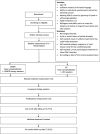Eye movement desensitization and reprocessing (EMDR) therapy or supportive counseling prior to exposure therapy in patients with panic disorder: study protocol for a multicenter randomized controlled trial (IMPROVE)
- PMID: 36918861
- PMCID: PMC10011792
- DOI: 10.1186/s12888-022-04320-4
Eye movement desensitization and reprocessing (EMDR) therapy or supportive counseling prior to exposure therapy in patients with panic disorder: study protocol for a multicenter randomized controlled trial (IMPROVE)
Abstract
Background: Exposure-based therapy is the treatment of choice for anxiety disorders, but many patients do not benefit sufficiently from it. Distressing images of threat related to the future or past may maintain the anxiety symptomatology or impede exposure therapy. An intervention that targets threat-related imagery is eye movement desensitization and reprocessing (EMDR) therapy. The main goal of this multicenter randomized controlled trial is to investigate whether EMDR therapy plus exposure therapy, relative to supportive counseling plus exposure therapy, improves treatment efficacy, tolerability, and adherence in patients with panic disorder. In addition, we will examine potential predictors of optimal treatment allocation, mechanisms of change as well as the long term effects of treatment. Finally, we will assess cost-effectiveness.
Methods: A multicenter randomized controlled trial mixed design will be conducted. Participants will be 50 patients, aged ≥ 18, diagnosed with a panic disorder. They will be randomly assigned to one of two conditions: EMDR therapy (i.e., flashforward strategy) or supportive counseling (each consisting of four weekly sessions of 90 min each) prior to exposure therapy (consisting of eight weekly sessions of 90 min each). Assessments will be made pre-treatment (T1), between-treatments (T2), post-treatment (T3), one month post-treatment (FU1) and six months post-treatment (FU2) by an assessor blind to treatment condition. The primary outcome measure is severity of panic-related symptoms. Secondary outcome measures are: tolerability of exposure therapy (initial avoidance, willingness to start exposure therapy, considered drop-out; no-show and drop-out), related symptomatology (generalized anxiety, depression), and functional impairment.
Discussion: The primary goals of this research are to compare the efficacy, tolerability, and adherence of EMDR therapy plus exposure therapy and supportive counseling plus exposure therapy and to identify predictors, moderators, and mediators for treatment success. This multi-center research aims to make a significant contribution to our understanding as to how treatment for patients with anxiety disorders can be optimized, and elucidate who can benefit most from this novel approach.
Trial registration: ISRCTN-ISRCTN29668369: Improving anxiety treatment by modifying emotional memories before real-life exposure. Registered 27 June 2022-retrospectively registered. ISRCTN-ISRCTN29668369.
Keywords: Anxiety Disorder; Cognitive-Behavioral Therapy (CBT); Exposure Therapy; Eye Movement Desensitization and Reprocessing (EMDR) therapy; Panic Disorder; Randomized Controlled Trial; Supportive Counseling.
© 2023. The Author(s).
Conflict of interest statement
Suzy Matthijssen and Ad de Jongh receive fees from teaching and/or supervising psychologists in EMDR therapy and exposure therapy by means of seminars, workshops, conferences and book royalties. For this study, the Digital_EMDR app was made available free of charge by MOOVD, a company specializing in virtual reality applications in the treatment of mental health. Suzy Matthijssen and Ad de Jongh participate in the MOOVD advisory board (stipendiary). Agnes van Minnen receives fees from teaching and supervising psychologists exposure therapy by means of seminars, workshops, conferences and book royalties. All other authors declare they have no competing interests.
Figures
Similar articles
-
A multi-site single blind clinical study to compare the effects of prolonged exposure, eye movement desensitization and reprocessing and waiting list on patients with a current diagnosis of psychosis and co morbid post traumatic stress disorder: study protocol for the randomized controlled trial Treating Trauma in Psychosis.Trials. 2013 May 23;14:151. doi: 10.1186/1745-6215-14-151. Trials. 2013. PMID: 23702050 Free PMC article. Clinical Trial.
-
Eye movement desensitization and processing for adolescents with major depressive disorder: study protocol for a multi-site randomized controlled trial.Trials. 2023 Mar 20;24(1):206. doi: 10.1186/s13063-023-07226-y. Trials. 2023. PMID: 36941688 Free PMC article.
-
The effect of eye movement desensitization and reprocessing (EMDR) on abdominal pain in patients with irritable bowel syndrome (IBS): a study protocol for a randomized controlled trial (EMDR4IBS).Trials. 2023 Dec 4;24(1):785. doi: 10.1186/s13063-023-07784-1. Trials. 2023. PMID: 38049872 Free PMC article.
-
The effectiveness of eye movement desensitization and reprocessing toward anxiety disorder: A meta-analysis of randomized controlled trials.J Psychiatr Res. 2020 Apr;123:102-113. doi: 10.1016/j.jpsychires.2020.01.005. Epub 2020 Jan 28. J Psychiatr Res. 2020. PMID: 32058073 Review.
-
Psychological therapies for the treatment of post-traumatic stress disorder in children and adolescents (Review).Evid Based Child Health. 2013 May;8(3):1004-116. doi: 10.1002/ebch.1916. Evid Based Child Health. 2013. PMID: 23877914 Review.
References
-
- American Psychiatric Association. Diagnostic and statistical manual of mental disorders. 5th ed. text revision. American Psychiatric Association Publishing; 2022. Section 2, Anxiety disorders [Cited 2022 Nov 1]. Avalable from: https://doi-org.proxy.library.uu.nl/10.1176/appi.b. - DOI
-
- Vos T, Flaxman AD, Naghavi M, Lozano R, Michaud C, Ezzati M, et al. Years lived with disability (YLDs) for 1160 sequelae of 289 diseases and injuries 1990–2010: a systematic analysis for the global burden of disease study 2010. Lancet. 2012;380(9859):2163–2196. doi: 10.1016/s0140-6736(12)61729-2. - DOI - PMC - PubMed
Publication types
MeSH terms
LinkOut - more resources
Full Text Sources
Medical
Miscellaneous



